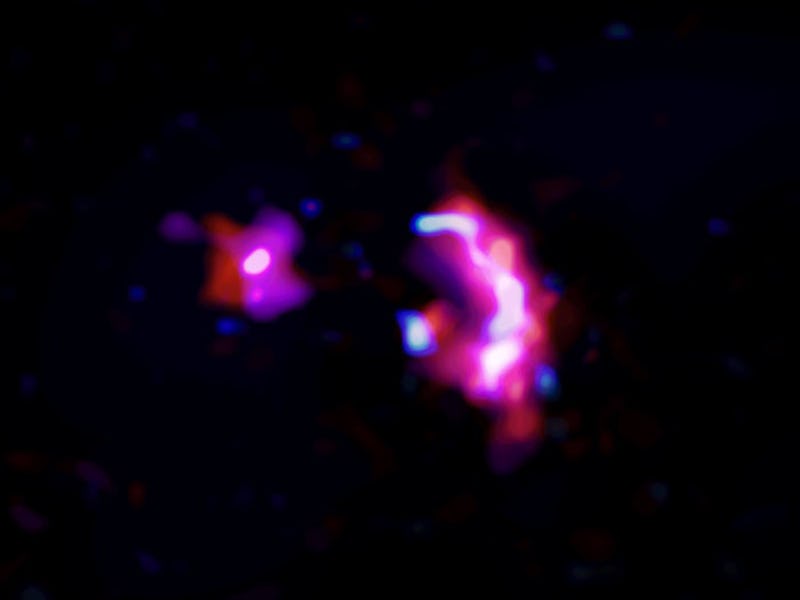Scientists just found water in the most distant part of the universe so far
How it got there remains a mystery.

The early universe is shrouded in mystery. But every now and then, astronomers get a peek at what the cosmos were like by peering back in time at distant, ancient galaxies. And galaxy SPT0311-58 just proved how much scientists don’t know about the young universe.
Scientists found water in the galaxy, which is located nearly 12.88 billion light years away. This marks the most distant detection of H2O in a star-forming galaxy, and the most comprehensive look at molecular gas that early in the universe’s timeline.
The team detailed their findings in a study published Wednesday in The Astrophysical Journal and available on the pre-print server Arxiv.
What’s new — Sreevani Jarugula, an astronomer at the University of Illinois and lead author of the new study, first spotted the galaxy SPT0311-58 in 2017 and was struck by how much dust and gas were in the galaxy.
“We wanted to know what the molecule content of the galaxy is,” Jarugula tells Inverse. The team detected both water and carbon monoxide molecules.
This galactic pair was found early on in the universe, just after the cosmos was completely dark.
SPT0311-58 is actually made up of a pair of galaxies that appear to be merging.
“So it’s actually a very elongated structure, which is very clumpy,” Jarugula says. “There are so many clumps in that galaxy; it’s not like a smooth galaxy.”
The brighter galaxy is located on the right of the image, shaped sort of like an arc. It appears so clearly despite its distance because it is gravitationally lensed by a massive nearby galaxy.
Gravitational lensing is a cosmic effect that acts like a giant magnifying lens. When a large object like a star or galaxy passes in front of an object in the background from the observer’s point of view, it distorts and amplifies the light coming from a distant source, making it appear brighter.
The molecules in the galaxy are magnified by this other galaxy, making it easier to observe them.
What they found — Scientists are able to detect H2O as the dust absorbs the ultraviolet radiation from the stars in the galaxy and re-emits it as far-infrared photons, which excites the water molecules. This creates water emissions which scientists can observe.
The water molecules appear in blue, while carbon monoxide appears in purple.
Water is the third most abundant molecule in the universe after molecular hydrogen and carbon monoxide, but scientists were surprised to see water molecules so early on in the universe.
The gravitational lensing effect made it easier to spot the molecules in this distant galaxy.
Here’s the background — The galactic pair are located in an era known as the Epoch of Reionization.
The Epoch of Reionization marks the end of the universe’s dark ages and refers to the period in the universe’s timeline when neutral hydrogen was reionized. Before this, neutral hydrogen caused interstellar space to be opaque, blocking light from extending far. This marked the arrival of the first large galaxies.
This period took place when the universe was approximately 780 million years old, only five percent of its current age (scientists estimate the universe to be around 13.8 billion years old).
If the first galaxies were just starting to emerge, the latest discovery has scientists wondering how these molecules were able to form so quickly.
“How has so much dust and gas accumulated so early on in the universe?” Jarugula says. “The dust you get is mostly from stars, which are pulsating and giving out their outer layer of dust into the galaxy.”
“So you need a good amount of stars to produce this dust,” she adds.
What’s next — Scientists are not sure where else the dust could have come from, or the initial stars from which the dust may have formed.
These ancient galaxies formed stars at a rate thousands of times that of the Milky Way, according to Jarugula. Therefore, studying distant galaxies informs scientists just how many stars were being produced and the rate at which gas in early galaxies was converted into stars.
By observing these galaxies, scientists can turn back to their models of the early universe and constrain its properties.
“So one galaxy is not gonna answer the question,” Jarugula says. “It’s going to be a statistic of galaxies, which will be helpful in constraining such models and answering the physics of how the conditions were in that early universe.”
Abstract — SPT0311-58 is the most massive infrared luminous system discovered so far during the Epoch of Reionization (EoR). In this paper, we present a detailed analysis of the molecular interstellar medium at z = 6.9, through high-resolution observations of the CO(6-5), CO(7-6), CO(10-9), [CI](2-1), and p-H2O(211-202) lines and dust continuum emission with the Atacama Large Millimeter/submillimeter Array (ALMA). The system consists of a pair of intensely star-forming gravitationally lensed galaxies (labelled West and East). The intrinsic far-infrared luminosity is (16 ± 4)×1012 L⊙ in West and (27 ± 4)×1011 L⊙ in East. We model the dust, CO, and [CI] using non-local thermodynamic equilibrium radiative transfer models and estimate the intrinsic gas mass to be (5.4 ± 3.4)×1011 M⊙ in West and (3.1 ± 2.7)×1010 M⊙ in East. We find that the CO spectral line energy distribution in West and East are typical of high-redshift sub-millimeter galaxies (SMGs). The CO-to-H2 conversion factor (αCO) and the gas depletion time scales estimated from the model are consistent with the high-redshift SMGs in the literature within the uncertainties. We find no evidence of evolution of depletion time with redshift in SMGs at z > 3. This is the most detailed study of molecular gas content of a galaxy in the EoR to-date, with the most distant detection of H2O in a galaxy without any evidence for active galactic nuclei in the literature.